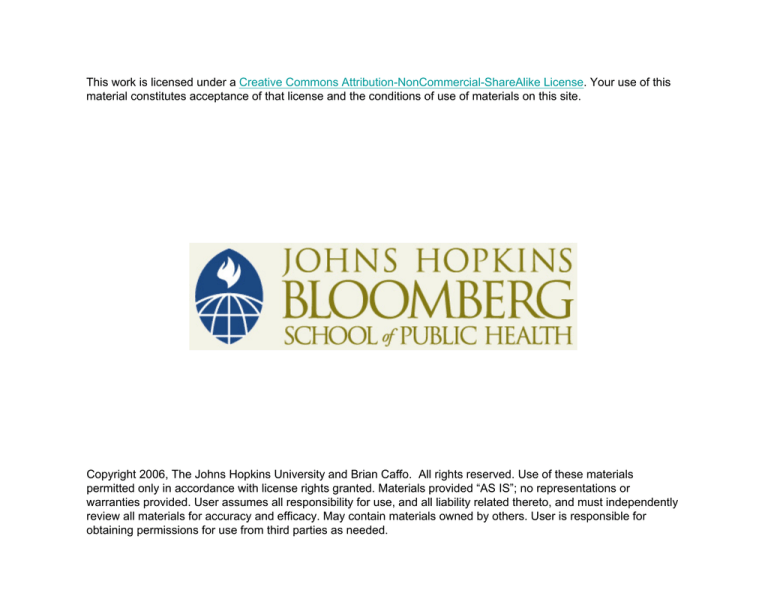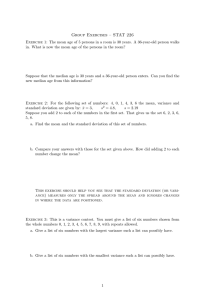
This work is licensed under a Creative Commons Attribution-NonCommercial-ShareAlike License. Your use of this
material constitutes acceptance of that license and the conditions of use of materials on this site.
Copyright 2006, The Johns Hopkins University and Brian Caffo. All rights reserved. Use of these materials
permitted only in accordance with license rights granted. Materials provided “AS IS”; no representations or
warranties provided. User assumes all responsibility for use, and all liability related thereto, and must independently
review all materials for accuracy and efficacy. May contain materials owned by others. User is responsible for
obtaining permissions for use from third parties as needed.
Lecture 3
1. Define expected values
2. Properties of expected values
3. Unbiasedness of the sample mean
4. Define variances
5. Define the standard deviation
6. Calculate Bernoulli variance
Expected values
The expected value or mean of a random variable is
the center of its distribution
For discrete random variable X with PMF p(x), it is
defnied as follows
E[X] =
X
xp(x).
x
where the sum is taken over the possible values of x
represents the center of mass of a collection of
locations and weights, {x, p(x)}
E[X]
Example
• Suppose
a coin is flipped and X is declared 0 or 1 corresponding to a head or a tail, respectively
• What
is the expected value of X ?
E[X] = .5 × 0 + .5 × 1 = .5.
Example
Suppose that a die is tossed and X is the number face
up
What is the expected value of X ?
1
1
1
1
1
1
E[X] = 1 × + 2 × + 3 × + 4 × + 5 × + 6 × = 3.5.
6
6
6
6
6
6
Continous random variables
• For
a continuous random variable, X , with density, f ,
the expected value is defined as follows
E[X] =
Z ∞
tf (t)dt.
−∞
• This
definition borrows from the definition of center
of mass for a continous body
Example
• Consider
a density where f (x) = 1 for x between zero
and one
• (Is
this a valid density?)
• Suppose
that X follows this density; what is its expected value?
1
x2 E[X] =
xdx =
= 1/2.
2 0
0
Z 1
Rules about expected values
• The
expected value is a linear operator
• If a
and b are not random and X and Y are two random variables then
◮ E[aX + b] = aE[X] + b
◮ E[X + Y ] = E[X] + E[Y ]
• In
general if g is a function that is not linear,
E[g(X)] 6= g(E[X])
• For
example, in general, E[X 2] 6= E[X]2
Example
You flip a coin, X and simulate a uniform random number Y , what is the expected value of their sum?
E[X + Y ] = E[X] + E[Y ] = .5 + .5 = 1
Another example, you roll a coin twice. What is the
expected value of the average?
Let X1 and X2 be the results of the two rolls
1
1
E[(X1 + X2)/2] = (E[X1] + E[X2]) = (3.5 + 3.5) = 3.5
2
2
Example
1. Let Xi for i = 1, . . . , n be a collection of random variables, each from a distribution with mean µ
2. Calculate the expected value of the sample average of
the Xi.
n
n
X
X
1
1
E
Xi = E
Xi
n
n
i=1
i=1
=
n
X
1
n
1
=
n
i=1
n
X
i=1
E [Xi]
µ = µ.
Remark
Therefore, the expected value of the sample mean is
the population mean that it’s trying to estimate
When the expected value of an estimator is what its trying to estimate, we say that the estimator is unbiased
The variance
• The
variance of a random variable is a measure of
spread.
• If X
is a random variable with mean µ, the variance
of X is defined as
Var(X) = E[(X − µ)2].
the expected (squared) distance from the mean
• Densities
with a higher variance are more spread out
than densities with a lower variance
• Convenient
computational form
Var(X) = E[X 2] − E[X]2.
• If a
is constant then Var(aX) = a2Var(X)
• The square root of the variance is called the standard
deviation
• The
standard deviation has the same units as X
Example
What’s the sample variance from the result of a toss of
a die?
E[X] = 3.5
E[X 2] = 12 × 61 + 22 × 16 + 32 × 61 + 42 × 16 + 52 × 61 + 62 × 16 = 15.17
Var(X) = E[X 2] − E[X]2 ≈ 2.92
Example
What’s the sample variance from the result of the toss
of a coin with probability of heads (1) of p?
E[X] = 0 × (1 − p) + 1 × p = p
E[X 2] = E[X] = p
Var(X) = E[X 2] − E[X]2 = p − p2 = p(1 − p)
Example
• Suppose
that a random variable is such that 0 ≤ X ≤ 1
and E[X] = p
• Note X 2 ≤ X
so that E[X 2] ≤ E[X] = p
• Var(X) = E[X 2] − E[X]2 ≤ E[X] − E[X]2 = p(1 − p)
• Therefore
the Bernoulli variance is the largest possible for random variables bounded between 0 and 1







